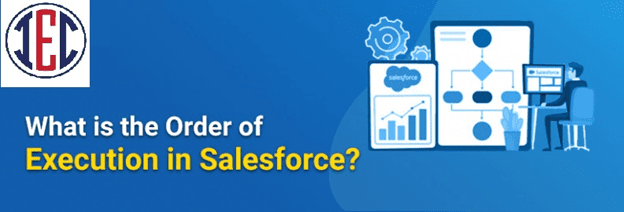Order of Execution in Salesforce In the world of Salesforce development, understanding the order of execution is akin to unraveling the intricate workings of a clock. Every process, trigger, and operation in Salesforce follows a specific sequence, impacting data integrity, automation, and overall system performance. In this blog, we’ll delve into the order of execution in Salesforce, demystifying its complexities and shedding light on its significance for developers and administrators.
The Foundation: Triggers and Processes
At the heart of Salesforce automation lie triggers and processes. Triggers are part of apex code that execute before or after a record is inserted, updated, or deleted. On the other hand, processes, including workflows, flows, and process builder, automate business processes by defining criteria and actions to be taken when those criteria are met.
The Sequential Flow
When an operation is initiated in Salesforce, whether it’s a user updating a record or an integration pushing data, the platform follows a precise order of execution:
- Validation Rules: Before any data is saved to the database, Salesforce checks whether it complies with the defined validation rules. These rules ensure data integrity and consistency within the organization.
- Before Triggers: If the record passes validation, any triggers configured to run before the operation are executed. These triggers often handle complex logic, data manipulation, or additional validations.
- Custom Processes (Workflow, Process Builder): After the triggers, custom processes defined using workflow rules, process builder, or flows are executed. These processes automate various business requirements, such as sending email alerts, updating fields, or creating related records.
- Assignment Rules: In scenarios where records are assigned to different users or queues based on predefined criteria, assignment rules are applied at this stage.
- Auto-Response Rules: For organizations utilizing case management, auto-response rules generate automatic email responses based on the characteristics of incoming cases.
- Validation Rules (Again): Following the application of assignment and auto-response rules, Salesforce re-evaluates the validation rules. This ensures that any changes made during the execution process still adhere to data integrity standards.
- Record Save: If all previous steps are completed successfully, the record is finally saved to the database.
- After Triggers: Once the record is saved, triggers configured to run after the operation are executed. These triggers often handle post-processing tasks, such as updating related records or sending notifications.
- Assignment Rules (Again): In some scenarios, particularly when records are updated or modified, assignment rules are reapplied to ensure proper assignment based on the updated criteria.
- Email Alerts, Outbound Messages: After the record is saved and all triggers have executed, any email alerts or outbound messages defined in the processes are sent.
- Workflow Field Updates, Approval Processes: Lastly, any field updates triggered by workflows or approval processes are applied to the record.
Significance and Best Practices
Understanding the order of execution in Salesforce is paramount for developers and administrators to build efficient, error-free automation processes. Here are some best practices:
- Minimize Complexity: Keep triggers and processes concise and focused on specific functionalities to avoid performance degradation and potential conflicts.
- Testing and Debugging: Thoroughly test automation processes to ensure they behave as expected under various scenarios. Utilize debug logs and system debug tools to identify and resolve issues.
- Documentation: Maintain comprehensive documentation outlining the order of execution, trigger logic, and process workflows to facilitate collaboration and troubleshooting.
- Continuous Optimization: Regularly review and optimize automation processes to align with evolving business requirements and Salesforce updates.
Conclusion
In the intricate ecosystem of Salesforce, the order of execution serves as the guiding framework for automation and data management. By understanding this sequential flow and adhering to best practices, developers and administrators can harness the full potential of Salesforce automation while ensuring data integrity, system performance, and user satisfaction. Embrace the order of execution, and unlock the power of seamless automation in Salesforce.
For more information& classes Call: 20-48553009
Registration Link: Click Here!
Author: Rohit Kumawat
Salesforce Trainer
IT Education Centre Placement & Training Institute
© Copyright 2024 | IT Education Centre.
